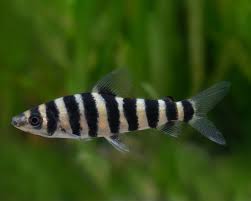Midwest Aquarium and Pond Supplier LLC
(8) Leporius Affins
(8) Leporius Affins
Precio habitual
$30.00 USD
Precio habitual
Precio de oferta
$30.00 USD
Los gastos de envío se calculan en la pantalla de pago.
Cantidad
No se pudo cargar la disponibilidad de retiro
"leporius affins" is a common misspelling of Leporinus affinis,
a species of freshwater fish from the Amazon River basin, also known as the many-banded or headstander leporinus. It is known for its torpedo-shaped body, distinctive stripes, and an active, sometimes territorial, temperament.
Appearance
- Coloration: When mature, they have a yellow body with nine thick, black vertical stripes. Young leporinus may have fewer stripes, which will split and increase in number as they grow older.
- Body: They have an elongated, torpedo-shaped body, with a mouth and teeth adapted for their diet.
-
Size:
L. affinis can grow up to 10–12 inches (25–30 cm) in length.
Care and tank setup
- Tank size: A minimum of a 75-gallon tank is recommended for a single specimen, with a larger tank being necessary for a group. The tank should be well-oxygenated and have a strong water current to mimic their natural river habitat.
-
Water parameters: They are adaptable but prefer clean, stable water conditions.
-
Temperature:
73–82°F (23–28°C).
- pH: 5.5–7.7.
-
Temperature:
- Aquascaping: Provide plenty of open swimming space, along with driftwood and rocks for shelter. Live plants will likely be eaten, so artificial plants can be used instead.
-
Lid:
A tight-fitting and heavy lid is essential, as leporinus are known for their jumping ability.
Diet and feeding
- Omnivorous: Though they have a strong preference for vegetable matter, leporinus are omnivores and should be fed a varied diet.
- Foods: Include high-quality pellets, spirulina flakes, and fresh vegetables like cucumber or peas. Supplement with meaty foods like bloodworms and brine shrimp.
Behavior and tank mates
- Temperament: While generally peaceful, they can be territorial and aggressive toward smaller fish and their own species. They are also known to be fin-nippers.
- Schooling behavior: In the wild, they live in large groups. To minimize aggression in a home aquarium, it is best to either keep a single specimen or a larger group of 8 or more, as this diffuses any hostility.
-
Compatible tank mates:
- Larger, robust fish: Non-aggressive cichlids, large tetras, and robust catfish.
-
Incompatible tank mates:
-
Smaller or slow-moving fish:
Anything small enough to be eaten or with long, flowing fins.
-
Smaller or slow-moving fish:
Share
No reviews

